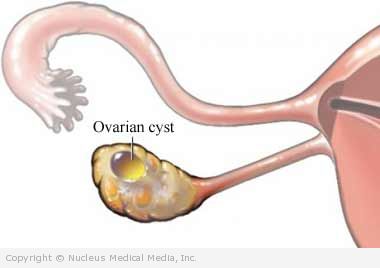(Follicular Cyst; Functional Cyst; Mittelschmertz; Corpus Luteum Cyst)
Ovarian cyst – Definition
An ovarian cyst is a fluid-filled sac in the ovary. During the menstrual cycle, it is normal for a cyst to develop. Most cysts are small and benign (not cancerous) and go away on their own. Larger cysts can cause pain and other problems.
Ovarian cyst – Causes
Follicles grow in the ovaries each month during childbearing years. Each month, in an ovary, at least one egg matures in its follicle. The egg and follicle become a small functional cyst. It makes hormones and during ovulation will release an egg. In some cases, these follicles may enlarge enough to become cysts. They are also known as functional cysts. There are two main types:
- Follicular cyst — This occurs when a follicle does not mature properly. The egg is not released. The follicle and egg develop into a cyst. This type of cyst goes away on its own within 1-3 menstrual cycles.
- Corpus luteum cyst — This occurs after an egg is released from the follicle during ovulation. Fluid builds up in the follicle and creates a cyst. This type of cyst goes away on its own in a few weeks.
Other, less common types of benign cysts can also form from ovarian tissue:
- Dermoid cyst — This cyst is made up of tissue from other parts of the body.
- Endometrioma — Endometrial tissue (lining of uterus) appears to be able to move away from the uterus to the ovary. Cysts may grow and become filled with fluid (often blood).
- Cystadenoma — This cyst grows from cells that line the outside of the ovary. Cystadenoma can become large and painful.
In a small number of cases, some cysts undergo cancerous changes. The doctor will carefully examine each cyst.
Ovarian cyst – Risk Factors
All women who still have monthly menstrual cycles are at risk for developing cysts.
Ovarian cyst – Symptoms
Most ovarian cysts do not cause symptoms. In some cases, though, a cyst may become twisted. This can cause pain in the lower abdomen. Some cysts may also rupture releasing fluid into the abdomen. This fluid can irritate the lining of the abdomen and cause pain. The pain may be on one or both sides of the lower abdomen. Also, large cysts may cause a sensation of pressure in the abdomen. Cysts can also cause urinary or bowel problems if they press on the bladder or bowel.
Ovarian cyst – Diagnosis
The doctor will ask about your symptoms and medical history. A pelvic exam will also be done. Cysts are often found during routine pelvic exams when there are no symptoms.
If a cyst is suspected or found, the doctor may do a pelvic ultrasound to determine the:
- Type and size of the cyst
- Type of treatment needed (if any)
Other tests or procedures (eg, laparoscopy, blood tests) may be used if a cyst:
- Does not go away after several menstrual cycles
- Gets larger and more painful
- Does not appear to be a simple functional cyst
Ovarian cyst – Treatment
Treatment depends on factors like your age, menstrual status, characteristics of the cyst, and your symptoms.
In some cases, the doctor takes a “wait and see” approach to see if the cyst will go away on its own.
If treatment is needed, options may include:
Medication
If you have a functional cyst, your doctor may prescribe birth control pills. While taking birth control pills will not make the cyst that you have go away, the pills can help prevent further cysts from forming.
If your cyst is causing a lot of discomfort, your doctor may prescribe pain medicine. But, if the cyst is causing a lot of pain, it may need to be removed.
Surgery
Laparoscopic surgery (minimally invasive approach) may be recommended to remove a cyst if it:
- Grows larger or reaches a size greater than two inches
- Has some solid material in it or other features
- Causes persistent or worsening symptoms
- Lasts longer than two or three menstrual cycles
- Disrupts blood flow
Ovarian cyst – Prevention
While there are not clear ways to prevent cysts from forming, you can take steps to take care of yourself by:
- Telling your doctor about any changes in your menstrual cycle
- Reporting pelvic and abdominal pain

